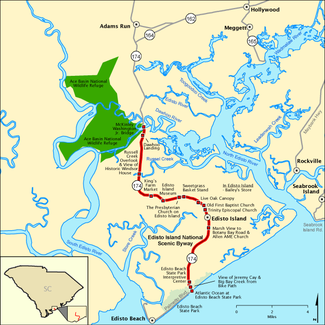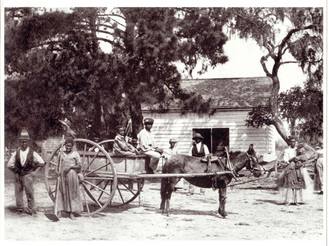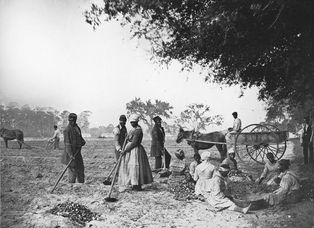Family History
 Edisto Island National Scenic Byway
Edisto Island National Scenic Byway
The first Africans came to Edisto Island in about 1684 and were a key element in establishing the island’s planter class, many of whom amassed huge fortunes. Once freed, many former slaves remained on the island and continued to Edisto’s rich cultural heritage.
According to U.S. Census data, the 1860 Colleton County population included 9,255 whites, 354 "free colored" and 32,307 slaves. By the 1870 census, the white population had dropped only slightly to 8,909, but the "colored" population had dropped almost in half to 16,492. Where did all these freed slaves go? From the available information, it appears that Colleton County slaves left in larger numbers than those from any other County in South Carolina. Charleston County saw an increase in colored population of almost two thirds between 1860 and 1870, so likely that is where many went. No other South Carolina County showed a significant increase.
Some call it the 1870 the Brick Wall. Others call it the 1870 Divide. It is one of the most frustrating challenges of African American heritage research - getting back beyond the 1870 Census to learn the name of the final slaveholder, and find the names of enslaved ancestors. The 1870 Census was the first to list freed African Americans by name. The 1860 Census listed only the age and gender of enslaved people, and plantation records, wills, estate inventories and bills of sale often listed only the first names of slaves.
To complicate matters, fewer than 20% of freed families in the Lowcountry adopted the name of the final slaveholder, so surname is most often not a good indicator of which slaveholding family's records hold the keys to your family's heritage. Because of these challenges, many family historians find their research stalled at the 1870 Census.
Based on the oral history and other historical documents I have gathered, the earliest ancestor I can find at this point is Richard Washington.
Richard Washington was born about 1858 (just a few years before the emancipation of slaves in 1862) in Edisto Island, South Carolina. There is no record if he was born to free parents. He had four sons and three daughters with Daphney Grant between 1875 and 1900. He died on July 8, 1929, in James Island, South Carolina, at the age of 71. Their children include: Roxy Washington (Scott), Ben Washington, Celia Washington (Chisolm), George Washington, Jacob Washington, Charles Washington, and Eloise Washington (Toglio).
I can't be sure which of the many plantations Richard Washington was born and raised, but the pictures below show typical plantation life.
According to U.S. Census data, the 1860 Colleton County population included 9,255 whites, 354 "free colored" and 32,307 slaves. By the 1870 census, the white population had dropped only slightly to 8,909, but the "colored" population had dropped almost in half to 16,492. Where did all these freed slaves go? From the available information, it appears that Colleton County slaves left in larger numbers than those from any other County in South Carolina. Charleston County saw an increase in colored population of almost two thirds between 1860 and 1870, so likely that is where many went. No other South Carolina County showed a significant increase.
Some call it the 1870 the Brick Wall. Others call it the 1870 Divide. It is one of the most frustrating challenges of African American heritage research - getting back beyond the 1870 Census to learn the name of the final slaveholder, and find the names of enslaved ancestors. The 1870 Census was the first to list freed African Americans by name. The 1860 Census listed only the age and gender of enslaved people, and plantation records, wills, estate inventories and bills of sale often listed only the first names of slaves.
To complicate matters, fewer than 20% of freed families in the Lowcountry adopted the name of the final slaveholder, so surname is most often not a good indicator of which slaveholding family's records hold the keys to your family's heritage. Because of these challenges, many family historians find their research stalled at the 1870 Census.
Based on the oral history and other historical documents I have gathered, the earliest ancestor I can find at this point is Richard Washington.
Richard Washington was born about 1858 (just a few years before the emancipation of slaves in 1862) in Edisto Island, South Carolina. There is no record if he was born to free parents. He had four sons and three daughters with Daphney Grant between 1875 and 1900. He died on July 8, 1929, in James Island, South Carolina, at the age of 71. Their children include: Roxy Washington (Scott), Ben Washington, Celia Washington (Chisolm), George Washington, Jacob Washington, Charles Washington, and Eloise Washington (Toglio).
I can't be sure which of the many plantations Richard Washington was born and raised, but the pictures below show typical plantation life.

Taken in the spring of 1862 on James Hopkinson's plantation, Edisto Island, South Carolina. Cassina Point was built in 1847 for Carolina Lafayette Seabrook and her husband, James Hopkinson. Carolina Seabrook was the daughter of wealthy Edisto planter William Seabrook. When James Hopkinson, owner of a plantation on Edisto Island, left South Carolina in 1862, he left behind over fifty slaves.

James Hopkinson's Plantation. Planting sweet potatoes, African American men and women hoe and plow the earth while others cut piles of sweet potatoes for planting. Early in the Civil War, on November 7, 1861, a fleet of Union gunboats bombarded the Sea Islands off the coast of South Carolina. Confederate planters left
hastily, ordering their field hands and house servants to accompany them. Most ignored their former masters and remained.
hastily, ordering their field hands and house servants to accompany them. Most ignored their former masters and remained.